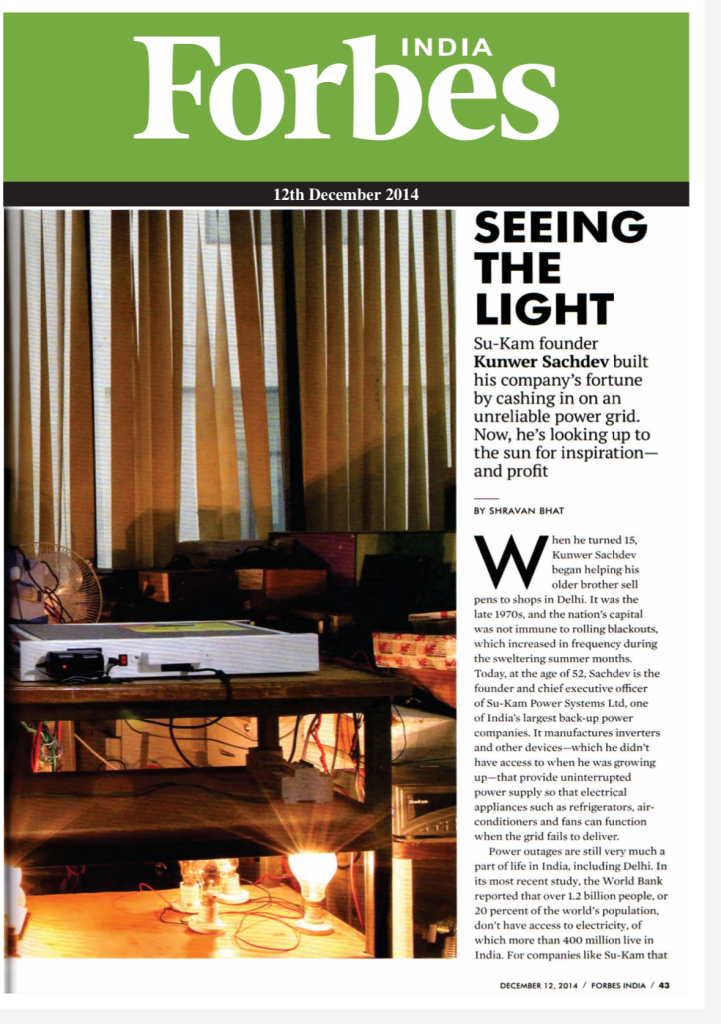Su-Kam founder Kunwer Sachdev built his company’s fortune by cashing in on an unreliable power grid. Now, he’s looking up to the sun for inspiration—and profit
BY SHRAVAN BHAT
When he turned 15, Kunwer Sachdev began helping his older brother sell pens to shops in Delhi. It was the late 1970s, and the nation’s capital was not immune to rolling blackouts, which increased in frequency during the sweltering summer months. Today, at the age of 52, Sachdev is the founder and chief executive officer of Su-Kam Power Systems Ltd, one of India’s largest back-up power companies. It manufactures inverters and other devices—which he didn’t have access to when he was growing up—that provide uninterrupted power supply so that electrical appliances such as refrigerators, air-conditioners and fans can function when the grid fails to deliver.Power outages are still very much a part of life in India, including Delhi. In its most recent study, the World Bank reported that over 1.2 billion people, or 20 percent of the world’s population, don’t have access to electricity, of which more than 400 million live in India. For companies like Su-Kam that benefit when the lights go off, business has never been better. Su-Kam’s revenues for 2013-14 stand at Rs 1,200 crore, up by 20 percent from 2012-13.These days, though, Sachdev has been paying close attention to Prime Minister Narendra Modi’s promise of replicating Gujarat’s 24-hour power supply model across the whole of India. And industry analysts believe that this goal can be achieved over the next five to 10 years. It’s also why the first-generation entrepreneur, who attributes his success to his ability to plan for future needs, is looking up to the sun for inspiration—and profit.Su-Kam is betting on individual home owners generating solar power to reduce their electricity bills. The majority of consumers currently plug inverters and UPS batteries to their appliances, which then charge and hoard power from the main grid. Sachdev has flipped this model: He has started manufacturing inverters and UPS devices that can draw power from solar panels, which Su-Kam began manufacturing in 2004.“We started research and development [R&D] for regular inverters in 2000. We don’t have to do anything special for solar-powered products. I’m already dealing in batteries, which use direct current [DC]. Solar panels also use DC. All I have to do is replace the battery in a regular inverter with a solar powered one,” says Sachdev.He may not have an engineering degree, but he knows the nuts and bolts of the technology Su-Kam is betting on. “We started manufacturing solar-powered products a decade ago, and today it accounts for 20 percent of our sales,” he says.Su-Kam offers solar solutions for homes and businesses. Apart from solar panels and hybrid UPS devices, it manufactures solar batteries, inverters, home lighting systems and network management systems. Sachdev wants to decentralise the power generating process. Instead of setting up large projects (more than 25 MW) that harness sunlight and sell electricity to the government’s central power grid, Su-Kam is selling smaller 5 kilowatts (KW) to 1 MW solar-powered systems to villages and housing complexes.“We don’t sell to the government, which involves sourcing land to generate the required 25-30 MW of power. Here, the customer provides the land and we provide the technology,” says Sachdev. “Whatever the solar unit produces will get ‘mixed’ into the customer’s normal power supply because of which a household’s bill will reduce. You recover the investment in a few years, and the burden on the government to generate more power is lessened.”Sachdev’s solar solutions plans are intriguing because they form a sort of hybrid between completely decentralised solutions such as individual solar lanterns and large solar farms.
https://kunwersachdev.com/a-spark-ignites-behind-the-scenes-at-su-kam-manufacturing

